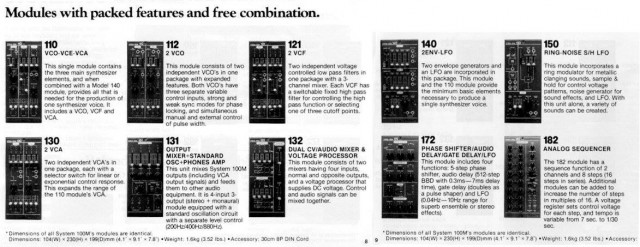With widespread reports that Roland will soon have a new modular product, it’s worth remembering: Roland has done modular before.
That legacy carried the name System-100. The original 100 semi-modular lineup of the late 70s, and the Synthesizer-101, might actually be more relevant today than it was when it first shipped. The clever concept here was to put a full-featured monosynth with a keyboard at the center, then add modules around it. That seems to make loads of sense to me, as it creates a playable instrument that can nonetheless be patched for more creative sound design options. The full line even included speakers, in a triumph of all-in-one industrial design; the modular components and speakers interlocked into a single cabinet.
Producer Björn Fogelberg jams a bit with the 101’s sample & hold circuitry, for a sense of what this beast is like to play. And have a listen to the sound: you could argue that this is one of the best-sounding instruments Roland ever built.

The 100m is probably a more appropriate model for whatever is coming from Roland next, but check out the stunning industrial design on the original System 100. This might inspire a custom Eurorack cabinet with keyboard, or two. Photo (CC-BY Notreshuggie.
The 100 was followed by the System 100m starting in 1979, produced through 1984 – see the vintage Roland ad at top for a look at what the modules were like. And here we have something that would look very much at home among Eurorack module offerings today; the design and layout are even similar. The 100m was a true modular system, rather than a semi-modular design as the Synthesizer-101 and companion components were. The notion was, as with today’s modulars, that you’d combine individual components into the instrument you wanted – oscillator, amplifier, mixer, envelope, filter, modulation, and so on.
There are some clues in the 100m line of what we might see in future from Roland. Apart from distinctive look and feel and interface design conventions, Roland’s 100m had some signature sound processors. The Ring Mod, Phase Shifter, and Sample & Hold might each make some appearance – and some sort of sequencer would be a no-brainer too.
Roland’s somewhat confusingly-named AIRA SYSTEM-1 made a nod to that history, though the actual design had nothing to do with it. I think whatever may be next from Roland will have something to do with the 100m. (And I can speculate freely, as I know nothing.)
But the 100m is worth a look, either way. Here’s a play on it filmed at the University of Huddersfield:
And, of course, don’t forget the mother of them all, the expansive System 700. While less likely to be a model for the AIRA offerings, it is a reminder of the days when Roland’s flagship synths were covered in patch cords.
Now, I know what you’re thinking: if only these beautiful antiques could have neon green on them, AIRA style. Okay, no, that’s probably not at all what you’re thinking.
But I think the sound modeling guts of the SYSTEM-1 have some real potential for more instruments from Roland. And I think the design of the 100/100m could well be a legacy worth building on. Any Roland entry into modular is unlikely to disrupt the existing boutique makers: part of the allure of modular is finding unique designs and archaic analog circuitry and digital code, the very opposite of what a builder like Roland represents. But if Roland has done a good job with this design, there’s no reason the two couldn’t coexist.
That might not strike your fancy if you only know the recent Roland, and haven’t really dug into some of the sounds the AIRA SYSTEM-1 can make (in its original, default mode), or if you don’t know the history of the System-100. But… if you do, you just might be watching for what happens at Roland’s booth at Musikmesse. Just days left, so get your advance speculating / ranting / trolling in now, while you still can.
